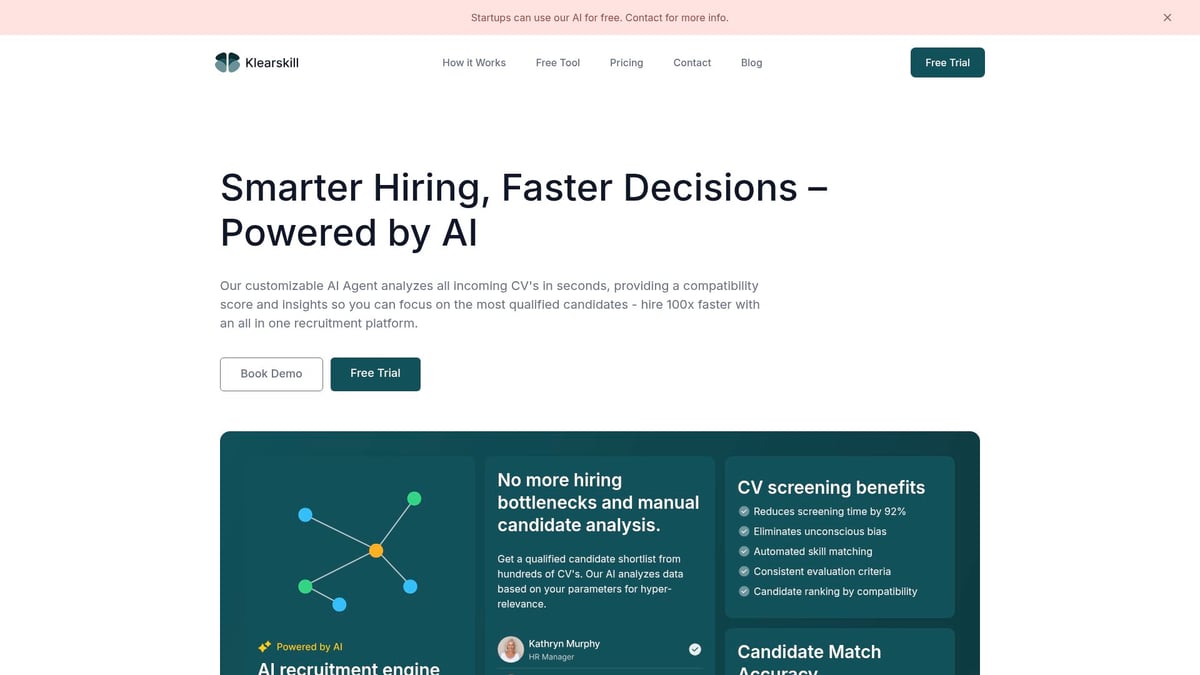October 9, 2025
Recruitment and Process Guide: Essential Steps for 2025

Effective recruitment and process management will shape organizational success in 2025. With talent shortages, evolving candidate expectations, and rapid digital transformation, companies face mounting pressure to adapt their recruitment and process strategies.
A streamlined and future-ready recruitment and process benefits both employers and candidates, leading to better hires, improved retention, and a stronger employer brand. This guide provides a comprehensive, actionable roadmap, integrating best practices, the latest technology, and compliance essentials.
You will discover step-by-step strategies for workforce planning, employer branding, sourcing, screening, selection, onboarding, and emerging trends—all designed to future-proof your recruitment and process.
Workforce Planning and Preparation
Strategic workforce planning is the foundation of every successful recruitment and process strategy. By anticipating future needs, organizations can align their hiring efforts with business goals, ensuring the right talent is in place for 2025. Effective preparation leads to better outcomes, reduced turnover, and a stronger employer brand.

Defining Organizational Needs and Role Requirements
Start by aligning workforce planning with your organization's long-term vision. Assess both current and future talent requirements using workforce analytics, which can reduce turnover by up to 20%. Review your existing team’s skills and map out gaps that may impact growth.
- Conduct skills gap analysis for key departments
- Create detailed job descriptions outlining skills, experience, and cultural fit
- Use data-driven forecasting to predict hiring volumes and timelines
Involve stakeholders from across the business to gather diverse perspectives. Consider referencing Workforce planning strategies for actionable frameworks to enhance your recruitment and process planning. This collaborative approach ensures that all role requirements reflect actual organizational needs.
Budgeting and Resource Allocation
Carefully plan your recruitment and process budget to maximize return on investment. Begin by outlining all expected costs, including:
- Advertising and employer branding campaigns
- Recruitment software, assessments, and background checks
- Agency fees or internal HR resources
- Onboarding expenses and training materials
Benchmark your spending against industry standards to avoid overspending or underspending. Allocate resources strategically between internal teams and external partners. Factor in emerging needs, such as technology investments, to keep your recruitment and process future-ready.
Building a Diverse and Inclusive Hiring Strategy
A robust recruitment and process approach for 2025 must prioritize diversity, equity, and inclusion. Set clear diversity targets and use inclusive language in every job advertisement. Implement unbiased screening practices, such as blind resume review, to minimize unconscious bias.
- Establish DEI training for all hiring managers
- Use structured interview formats for objective evaluation
- Monitor diversity metrics throughout the recruitment and process lifecycle
According to Randstad, 76% of job seekers consider diversity important when evaluating employers. Embedding DEI into your recruitment and process not only attracts top talent but also drives innovation and employee engagement.
Employer Branding and Candidate Attraction
A strong employer brand and effective candidate attraction strategies are crucial for a successful recruitment and process in 2025. As competition for top talent intensifies, organizations must stand out and connect authentically with potential hires at every stage.

Crafting a Compelling Employer Brand
Defining your employee value proposition (EVP) is foundational to the recruitment and process. Start by clarifying what sets your workplace apart, including culture, benefits, and growth opportunities.
Promote your EVP across multiple channels:
- Social media profiles and campaigns
- Company website career pages
- Employee testimonials and video stories
- Review platforms like Glassdoor
Consistent messaging on all channels builds trust and recognition. Share authentic employee experiences to humanize your brand and appeal to candidates' aspirations. Organizations with a well-communicated EVP see a measurable increase in candidate engagement and quality of applicants.
Writing Effective Job Descriptions and Postings
Clear, inclusive, and engaging job descriptions are essential in the recruitment and process. Use language that reflects your values and welcomes diverse backgrounds.
Best practices for impactful postings:
- Highlight growth and learning opportunities
- Emphasize company culture and team dynamics
- List benefits and unique perks
- Ensure content is optimized for SEO and mobile devices
Companies with optimized postings receive up to 50% more qualified applicants. To further enhance your efforts, explore actionable insights in the Recruitment best practices guide, which covers modern strategies for attracting top talent.
Sourcing Talent: Channels and Strategies
A diverse sourcing approach is vital for an effective recruitment and process. Go beyond traditional job boards to reach a wider talent pool.
Consider these sourcing channels:
- Social networks like LinkedIn and industry forums
- Employee referral programs
- University partnerships for early-career talent
- Talent pools and passive candidate outreach
Employer branding campaigns can help attract candidates for hard-to-fill roles. Engage passive talent through personalized outreach and highlight your organization's unique appeal to spark interest before positions are even posted.
Leveraging Recruitment Events and Networking
Recruitment events and networking are critical components of a robust recruitment and process. Participate in or host career fairs, industry webinars, and networking sessions to connect with talent ahead of hiring needs.
Building relationships early allows you to nurture a pipeline of engaged candidates. According to industry research, 70% of jobs are filled through networking activities. These events also showcase your employer brand in action, leaving a positive impression on potential hires.
Sourcing, Screening, and Shortlisting Candidates
Finding and selecting the right talent is at the heart of a successful recruitment and process for 2025. As hiring becomes more competitive, organizations must embrace advanced strategies to identify, assess, and engage candidates efficiently. Each step, from sourcing to shortlisting, directly impacts the quality and speed of hiring outcomes.
Proactive Sourcing Methods for 2025
Modern recruitment and process strategies rely on a blend of technology and creativity. Proactive sourcing in 2025 means using AI-driven tools to scan vast networks and databases for both active and passive talent. Recruiters tap into niche professional platforms, social media, and specialized forums to reach candidates who might not be actively searching.
Maintaining a robust talent pipeline is essential. By building relationships early, companies can quickly fill roles as needs arise. Automation also enables teams to scale outreach, personalize messages, and track responses efficiently. For more on how automation transforms sourcing, see this Recruitment automation tools overview.
Effective sourcing is not just about volume. It is about targeting the right fit, using data and analytics to predict candidate success, and staying ahead in the recruitment and process landscape.
Resume Screening and Candidate Assessment
Screening resumes and assessing candidates are foundational to the recruitment and process. Applicant tracking systems (ATS) streamline this phase by filtering out unqualified applicants based on set criteria. Structured scoring rubrics ensure every candidate is evaluated consistently, reducing the risk of subjective decision-making.
To further validate skills, organizations integrate practical assessments, cognitive tests, and scenario-based exercises. These methods provide objective data on a candidate's abilities and potential fit. Combining automated screening with human oversight results in a balanced, effective approach.
A structured recruitment and process like this not only saves time but also increases the likelihood of finding top talent who align with organizational goals.
Reducing Bias and Enhancing Objectivity
Eliminating bias is a priority in any recruitment and process. Blind screening techniques, such as anonymized resumes, help ensure decisions are based on merit rather than unconscious assumptions. Structured interviews, where all candidates are asked the same questions and scored on a rubric, are proven to double the predictive accuracy of hiring outcomes compared to unstructured methods.
Regular training for recruiters on fair assessment practices further strengthens objectivity. Companies that invest in these measures create a more equitable hiring environment and boost their employer brand.
By embedding fairness at every stage, the recruitment and process becomes a driver of both diversity and business success.
AI-Powered CV Screening and Shortlisting Tools
AI-driven platforms have revolutionized the recruitment and process by automating resume analysis and candidate shortlisting. These tools use customizable algorithms to rank applicants based on skills, experience, and job fit. Organizations experience a 92% reduction in screening time and a 99% decrease in bias, with match accuracy reaching 97% for technical roles.

Integration with existing ATS is seamless, and real-time analytics offer actionable insights for smarter decisions. Companies adopting AI-powered screening report saving thousands of HR hours annually.
This approach elevates the recruitment and process by delivering speed, fairness, and accuracy, setting a new benchmark for hiring excellence.
Conducting Effective Initial Interviews
The initial interview stage is critical for the recruitment and process. Phone or video interviews allow recruiters to quickly assess motivation, communication, and alignment with company values. Using standardized questions ensures every candidate is evaluated on the same criteria, supporting objective comparison.
Recording and scoring responses further enhances transparency and consistency. This structured approach not only streamlines the process but also improves candidate experience.
A well-executed initial interview lays the foundation for deeper assessments and successful hiring decisions, making it a vital component of a future-ready recruitment and process.
Selection Process: Assessments, Interviews, and Decision Making
A robust selection strategy is the backbone of any effective recruitment and process. In 2025, organizations must implement structured, data-driven steps to ensure fair, objective, and high-quality hiring. Each stage, from interviews to decision-making, should emphasize transparency, consistency, and candidate experience.

Designing a Multi-Stage Interview Process
An effective recruitment and process begins with a well-defined, multi-stage interview structure. Start with an initial HR screening to assess motivation and basic qualifications. Follow this with a technical or skills-based interview tailored to the role. Conclude with a panel or culture-fit interview involving key stakeholders.
Assign clear roles for each interviewer and communicate the entire process to candidates at the outset. This transparency enhances trust and engagement. Multi-stage interviews can improve the quality of hire by up to 30 percent, according to SHRM.
For a visual breakdown of each step, refer to this Recruitment process flowchart, which supports a streamlined approach and helps teams stay aligned.
Skills and Psychometric Testing
Incorporating tailored assessments is essential for a future-ready recruitment and process. Technical tests measure job-specific skills, while psychometric assessments evaluate personality, cognitive abilities, and work style. Validated tools ensure fairness and relevance.
For each role, select assessments that align closely with the required competencies. Use digital platforms to deliver tests efficiently, especially for remote candidates. These assessments provide objective data and can reveal strengths that may not surface in interviews alone.
Structured vs. Unstructured Interviews
Choosing the right interview format is crucial for an unbiased recruitment and process. Structured interviews use standardized questions and scoring guides, ensuring each candidate is evaluated equally. In contrast, unstructured interviews rely on conversational flow, which may introduce inconsistency.
| Interview Type | Validity Coefficient | Bias Reduction | Consistency |
|---|---|---|---|
| Structured | 0.51 | High | High |
| Unstructured | 0.38 | Low | Low |
Structured interviews not only improve predictive accuracy but also help reduce unconscious bias, making them a best practice for modern hiring.
Panel Interviews and Collaborative Evaluation
Panel interviews are a cornerstone of a holistic recruitment and process. By involving multiple stakeholders, you gain diverse perspectives and minimize individual biases. Assign specific focus areas to each panelist, such as technical skills, cultural fit, or leadership qualities.
Use collaborative scoring sheets so all feedback is recorded transparently. After the interview, hold a debrief session to discuss observations and reach a consensus. This method increases fairness and supports more confident hiring decisions.
Reference and Background Checks
The next step in any recruitment and process is verifying the candidate’s background. Start by confirming employment history, educational credentials, and professional references. Conduct background checks in compliance with regional legal standards to mitigate risk.
Statistics show that 53 percent of resumes contain inaccuracies, making thorough checks essential. Document all findings and ensure consistent procedures for every candidate.
Making the Final Selection
Making the final hiring decision is a critical moment in the recruitment and process. Combine data from interviews, assessments, and reference checks. Hold calibration meetings with all decision-makers to discuss top candidates and align on selection criteria.
Document the entire decision-making process for transparency and future audit purposes. This structured approach ensures that offers are made to the most qualified and culturally aligned candidates.
Communicating with Candidates
Clear, timely communication is the final touchpoint in the recruitment and process. Notify all candidates of their status promptly, whether successful or not. Provide constructive feedback where possible to enhance the candidate experience.
A positive communication strategy protects your employer brand, as 80 percent of candidates who have a negative experience will share it publicly. Consistent updates and respectful closure foster trust, even among those not selected.
Offer Management, Onboarding, and Retention Strategies
A successful recruitment and process does not end with selecting a candidate. To secure long-term organizational success, it is essential to manage offers, onboard new hires effectively, and implement retention strategies that nurture talent and reduce turnover. Each step in this phase is vital for turning top candidates into engaged, productive employees.
Crafting Competitive Job Offers
Building a compelling offer is a cornerstone of a modern recruitment and process. Start by benchmarking salaries and benefits against current industry standards to ensure competitiveness. Personalize each offer to reflect the candidate’s unique motivations, such as remote work, flexible hours, or professional development opportunities.
Highlight clear growth paths and advancement options within the organization. A well-structured offer package should include:
- Base salary and bonus structure
- Benefits (health, wellness, retirement)
- Opportunities for skill development and promotion
Transparent communication throughout this stage helps candidates see the value of joining your team.
Negotiation and Acceptance
Negotiation is a natural part of the recruitment and process. Anticipate common negotiation points, including salary, benefits, remote work arrangements, and flexible schedules. Preparing for these topics ensures you can respond confidently and fairly.
Use transparent, open communication to build trust with candidates. Clearly explain how offers are structured and be upfront about what is negotiable. According to SHRM, organizations that practice transparent negotiation see a 15 percent increase in offer acceptance rates. This approach also sets a positive tone for the employment relationship.
Streamlined Onboarding Processes
A structured onboarding experience is essential for a successful recruitment and process. Design an onboarding plan that includes orientation, role-specific training, and mentorship. Leverage digital onboarding platforms to accommodate remote or hybrid hires, ensuring consistency and efficiency.
An effective onboarding process typically covers:
- Company culture and values introduction
- Technology and tools setup
- Clear performance expectations
Organizations with strong onboarding see up to an 82 percent improvement in new hire retention. Early engagement helps new employees feel welcomed and supported.
Early Engagement and Integration
The recruitment and process should extend into the early days of employment. Assign a buddy or mentor to guide new hires through their first weeks, fostering a sense of belonging. Set clear milestones and regular check-ins during the first 90 days to monitor progress and address any concerns.
Encourage participation in team activities and provide resources for learning about the company culture. Early integration increases confidence and reduces the likelihood of early turnover.
Retention-Focused Strategies Post-Hire
Ongoing retention is a natural extension of the recruitment and process. Implement continuous feedback mechanisms, regular performance reviews, and career development programs. Promote internal mobility and learning opportunities, as organizations with strong internal mobility see up to 50 percent lower turnover.
For more detailed strategies on developing internal mobility programs and retention best practices, refer to the 12 Recruitment Best Practices for 2025. Investing in these initiatives ensures employees remain engaged and motivated long after onboarding.
Compliance and Documentation
Ensure all legal and regulatory paperwork is completed throughout the recruitment and process. Maintain accurate records for audits and reporting. This includes contracts, background checks, tax forms, and any required certifications.
Proper documentation not only protects the organization but also creates a smooth experience for new hires, building trust from the outset.
Recruitment Technology and Future Trends for 2025
Staying ahead in the recruitment and process landscape requires organizations to embrace emerging technologies and anticipate changes shaping 2025. Companies that adapt early benefit from improved efficiency, stronger compliance, and a competitive edge in attracting top talent. This section explores the key technology trends and future-focused strategies every HR leader should know.
The Rise of AI and Automation in Recruitment
AI is rapidly transforming the recruitment and process journey for both employers and candidates. Automated tools now handle sourcing, screening, and candidate engagement, freeing HR teams to focus on strategic decisions. In fact, 67% of HR leaders plan to increase AI investments by 2025. AI-powered chatbots answer applicant questions instantly, while video interview platforms use algorithms to assess candidate responses and behaviors.
Adopting these solutions not only shortens time-to-hire but also enhances consistency in candidate evaluation. For a deeper dive into how AI is shaping hiring workflows, see Recruitment Best Practices Shaping 2025.
Data-Driven Recruitment and Talent Analytics
Organizations leveraging analytics in their recruitment and process strategies see measurable gains in efficiency and quality of hire. Tracking sourcing channels, diversity ratios, and assessment results enables data-driven decision-making. Predictive analytics helps forecast hiring needs and optimize workforce planning.
Data-driven companies are three times more likely to improve hiring outcomes. Regularly reviewing dashboards for trends ensures continuous improvement and alignment with business objectives. Integrating analytics into every stage of the process is no longer optional—it is essential.
Mobile and Remote Recruitment Solutions
With 58% of job seekers now applying via mobile, optimizing career sites and job applications for smartphones is crucial. Recruitment and process platforms must ensure seamless experiences across devices, from initial application to onboarding. Remote interviewing and digital onboarding tools have become standard, making it easier to connect with talent worldwide.
These technologies empower organizations to reach broader talent pools and adapt to hybrid or fully remote work models. Flexibility and accessibility are now expected by candidates in every industry.
Virtual Reality (VR) and Gamification in Assessment
Virtual reality is emerging as a powerful tool in the recruitment and process toolkit. VR platforms offer immersive job previews, allowing candidates to experience real workplace scenarios before joining. Gamified assessments engage applicants, measure problem-solving skills, and provide a dynamic alternative to traditional tests.
Research shows that VR assessments can boost candidate engagement by 40%. These innovations not only improve the candidate experience but also help employers identify true potential in a more interactive way.
Enhancing Candidate Experience with Technology
A positive candidate experience is vital to a successful recruitment and process. Automated scheduling tools, personalized status updates, and self-service portals keep applicants informed and engaged. Feedback platforms collect insights for continuous refinement.
According to recent data, 77% of candidates prefer automated updates during the process. For further insights on optimizing candidate experience and leveraging technology, explore Top Recruitment Trends and Practices for 2025.
Compliance, Ethics, and Data Privacy
As technology advances, so do responsibilities around compliance and ethics in the recruitment and process. HR teams must follow data protection laws such as GDPR and CCPA, ensuring candidate information is handled securely. AI tools should be transparent, explainable, and regularly audited for bias.
Continuous training helps recruiters use technology ethically and responsibly. Maintaining trust with candidates and regulators is non-negotiable in the digital age.
Preparing for the Future of Work
The future of recruitment and process is shaped by hybrid workplaces, the gig economy, and global talent pools. Companies must prioritize upskilling and reskilling, integrating these criteria into hiring strategies. Monitoring trends—like flexible contracts and emerging job types—keeps organizations agile.
Building a future-ready recruitment and process ensures organizations can attract, onboard, and retain talent in an evolving world of work.
